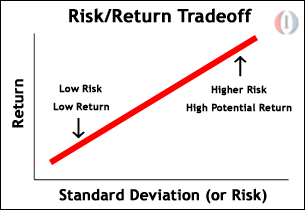|

|
The risk-return tradeoff is the balance between the desire for the lowest possible risk and the highest possible returns. In general, low levels of uncertainty (low risk) are associated with low potential returns and high levels of uncertainty (high risk) are associated with high potential returns.
Each investor must decide how much risk they’re willing and able to accept for a desired return. This will be based on factors such as age, income, investment goals and personality. It’s important to decide how much risk you can take on while still remaining comfortable with your investments: Too little risk and your earnings will suffer; too much risk and you won’t be able to sleep at night. The key is to find the balance where your earnings are acceptable and you’re not outside your comfort zone.
The following chart shows a visual representation of the risk/return tradeoff for investing, where a higher standard deviation means a higher level or risk – as well as a higher potential return.
 |
It’s important to keep in mind that higher risk doesn’t automatically equate to higher returns. The risk-return tradeoff only indicates that higher risk investments have the possibility of higher returns – but there are no guarantees.
Risk-free rate of return: the "control" by which actual risk is measured
On the lower-risk side of the spectrum is the risk-free rate of return – the theoretical rate of return of an investment with zero risk. It represents the interest you would expect from an absolutely risk-free investment over a specific period of time. In theory, the risk-free rate of return is the minimum return you would expect for any investment because you wouldn’t accept additional risk unless the potential rate of return is greater than the risk-free rate. In practice, however, the risk-free rate doesn’t exist because every investment has at least a very small amount of risk. (See also: How is the Risk-Free Rate of Interest Used to Calculate Other Types of Interest Rates or Loans?)
The interest rate on a three-month U.S. Treasury bill is often used as the risk-free rate for U.S.-based investors – the market considers there to be virtually no chance of the government defaulting on its obligations. As an example, assume the risk-free rate is 1.4%. Therefore, for virtually no risk, you can earn 1.4% per year on your money. Of course, 1.4% is low compared to other investments. Index funds, for example, average returns closer to 7%, and there are outlier investments where returns are in the triple-digits or even higher (think: Bitcoin). While it can be difficult to “see everyone else getting rich” on investments like Bitcoin, it’s important to remember those investors are taking on considerably more risk, including the loss of some or all their initial investment. One of the biggest decisions you make as an investor is selecting the appropriate level of risk. (For more, see: Financial Concepts: The Risk/Return Tradeoff.)
Risk and Diversification: Diversifying Your Portfolio
-
 Investing
InvestingWhy Risk-Free Investments Don't Exist
We explain the risks inherent with all types of investments and why risk-free investments do not exist. -
 Investing
InvestingHow to Calculate Risk Premium
Think of a risk premium as a form of hazard pay for risky investments. -
 Trading
TradingHow & Why Interest Rates Affect Futures
There are at least four factors that affect change in futures prices, including risk free-interest rates, particularly in a no-arbitrage environment. -
 Investing
InvestingHow to calculate required rate of return
The required rate of return is used by investors and corporate-finance professionals to evaluate investments. In this article, we explore the various ways it can be calculated and put to use. -
 Investing
InvestingThe Risks Associated with Common Investments
Investing inherently involves some risk. Here are some of the different types of investment risks. -
 Managing Wealth
Managing WealthModern Portfolio Theory: Why It's Still Hip
Investors still follow an old set of principles, known as modern portfolio theory (MPT), that reduce risk and increase returns through diversification. -
 Investing
InvestingLow-Risk vs. High-Risk Investments for Beginners
Understanding risk is key to better investing. Learn how to determine where risk lies and the difference between low risk and high risk are crucial. -
 Investing
InvestingRisk Tolerance and Your Personal Portfolio
To best manage your investment portfolio over the years, you need to determine your risk tolerance. How much risk you are willing to take? -
 Investing
InvestingDiversification: The Right Way to Manage Risk
Diversifying your portfolio across multiple asset classes will help you minimize investment risk.


